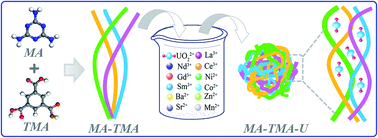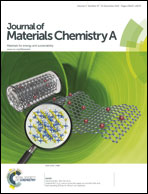An adaptive supramolecular organic framework for highly efficient separation of uranium via an in situ induced fit mechanism†
Abstract
On the basis of the unusual coordination structure of UO22+ combined with the adaptive nature of supramolecular organic frameworks (SOFs), here we have designed and prepared a novel SOF-based solid phase extraction adsorbent (MA–TMA) using N-donor-containing melamine (MA) and O-donor-containing trimesic acid (TMA) as bifunctional building blocks mutually linked via hydrogen bonds. The as-prepared MA–TMA, with a rich N-/N- and N-/O-heterocyclic structure throughout its framework, provides an accessible coordination geometry and/or ligand environment for the uranyl ion, which builds the crucial structural basis for the pre-organized adaptive frameworks closely related to the “induced-fit” and selective recognition of uranyl ions. The main results are as follows: (1) the highest selectivity of 92%, so far unreported, and a considerable capacity of 324 mg g−1 for uranium adsorption by MA–TMA are observed in weak acidic multi-cation solution (pH 2.5), accompanied by a distribution coefficient Kd value of 16 000 mL g−1, 100-fold or more over other 11 competitive cations; (2) MA–TMA could reach its limiting saturation capacity of 1028 mg g−1 at pH 4.5 in pure-U(VI) solution; (3) noteworthily, the morphology of MA–TMA changed from a ribbon-like structure with a nano-diameter before adsorption into aggregated granules with a size of tens of microns after adsorption, which would be much more favorable for subsequent solid–liquid separation. Furthermore, possible mechanisms for the selective recognition of uranyl ions and the morphological changes of MA–TMA after adsorption are explored based on experimental characterization and chemical rationale.


 Please wait while we load your content...
Please wait while we load your content...